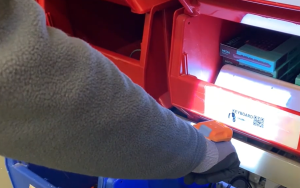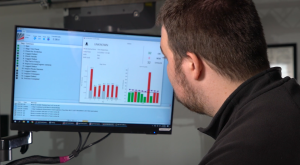
Smart-tech, automated manufacturing—commonly referred to as Industry 4.0— has created new ways for companies to get more value from their equipment and put manufacturers on a path to improve processes, productivity, and quality.
While automation can solve many business and manufacturing challenges, a survey by Kearney reports that humans continue to be the main driver of value on the factory floor, with 72% of factory tasks performed by people—suggesting that automation alone isn’t enough to propel manufacturers forward.
To be successful in the next manufacturing revolution (Industry 5.0), companies will need to employ augmentation alongside automation. Recent advancements in augmentation technologies that improve how workers do their jobs are helping manufacturers get more value from their people, making employees more productive and the company more competitive.
Augmented reality (AR), a key augmentation technology, is already making a profound impact on manufacturing and helping smart factories meet current industry demands by improving the quality of products created through manual processes. AR’s human-centric nature supports manual processes and solves common manufacturing challenges that automation alone cannot, such as:
- Bridging the skills gap and attracting young talent for more effective workforce development
- Capturing manual process data for a more holistic view of manufacturing operations
- Enhancing manufacturing technology integrations for improved asset utilization
These capabilities give manufacturers ground-breaking advantages in their digital transformations, benefiting all factory assets and providing the momentum to move beyond Industry 4.0 into Industry 5.0.
But, what is Industry 5.0, and what does it mean for manufacturers? How does AR propel it? And what can companies do NOW to position themselves for success and gain a competitive edge in the face of common challenges manufacturers are experiencing today?
What Is Industry 5.0?
Industry 4.0 resulted in the rise of smart technologies that led to a revolution of connectivity. Industry 5.0—the next revolution—advances collaboration between humans and machines. By using digital transformation to tie manual and automated processes together, manufacturers will be better able to meet the growing demand for increased product customization, variation, and personalization.
Put simply, Industry 5.0 will put people back at the center of manufacturing, giving machines the work they do best (repetitive tasks) and enabling people to apply cognitive reasoning to solve problems that advance quality and throughput. Higher value jobs will be created as production responsibilities shift back to workers, and production work will become more interesting and engaging—resulting in higher morale, improved recruiting, and higher retention.
The key to successfully navigating Industry 5.0 is adopting assistive technologies that empower workers to be more effective, and help companies get the best from automated and human performance.
Augmented reality is a key technology to meet these needs, spanning both Industry 4.0 and Industry 5.0, leading to greater agility and performance on the production line.
RELATED ARTICLE: What is Industry 5.0? The Next Manufacturing Revolution
![Laptop Assembly with LightGuide AR]()
Empowering the Workforce with Augmentation

According to research conducted by the World Economic Forum (WEF), augmented technologies, such as augmented reality, “[provide] opportunities to develop a human-centric vision of manufacturing to the benefit of both businesses and their employees.”
Unique in its ability to enhance human capability, AR offers several benefits for manufacturers, including:
- Enabling employees to acquire new skills and knowledge, creating a more accessible and inclusive work environment that improves employee well-being and safety
- Increasing the efficiency and effectiveness of industrial operations, and;
- Unlocking insights that lead to data-driven innovation
Enabling Employees to Acquire New Skills and Knowledge
Augmentation technologies give manufacturers the opportunity to enable lifelong learning and development of their workforce. For example, AR can enhance training through immersive, virtual learning that’s fast, agile, individualized, and engaging. In fact, research from the WEF shows that businesses reported an increase in training effectiveness by up to 80% compared to traditional training regimens. This improvement in training effectiveness has resulted in additional cost savings due to the ability to standardize and scale training programs at an enterprise level.
Creating a More Accessible and Inclusive Work Environment
Augmentation technology can reduce entry barriers to jobs. The use of inclusive and assistive manufacturing technology makes work accessible to a larger range of prospective employees. The benefits are both social and economic. Manufacturers can now help disabled workers achieve more autonomy in their lives and provide a path to greater economic participation. In the process, manufacturers can expand their workforce.
RELATED ARTICLE: Empowering the Social Economy with AR
Increasing Employee Well-Being and Improving Safety
Many manufacturing jobs can be physically demanding. Tasks such as heavy lifting may present health and safety risks for the workforce. One application of augmentation technology—for example, using exoskeletons or collaborative robots—aims to protect employees’ health, enabling them to remain safely in their preferred jobs for longer, regardless of age.
Sharing arduous work with assistive technology removes physical stress from workers. It allows for less short- and long-term health risks through improved ergonomics and puts focus on the health of the worker in a new way.
RELATED ARTICLE: Augmented Workforce: Empowering People, Transforming Manufacturing by WEF

Solving Manufacturing Challenges with Industry 5.0 Solutions
While Industry 5.0 can address age-old manufacturing challenges, the problems that have plagued the industry for years won’t solve themselves. Taking advantage of the benefits of Industry 5.0 will require manufacturers to solve current industry challenges first.
Consider the recurring problems that you’ve likely experienced:
- Closing the skills gap and attracting younger workers
- Measuring for success
- Agility and quick innovation
Thankfully, the journey to Industry 5.0 is all about solving these problems and more.
Address the Skills Gap with Augmentation
In manufacturing, change is constant. As job requirements change, employees must expand their skill set with minimal downtime to keep up with demand. And with pervasive digital transformation and the rise of smart manufacturing technologies, the skills gap is getting wider.
As the manufacturing workforce ages and retires, filling roles with new hires is becoming increasingly difficult. Young people are inspired by companies that commit to ingenuity, so, manufacturers need to make work attractive and fulfilling for them. Younger generations are accustomed to a life assisted by technology and expect their employers to be as high-tech as they are.
Upskilling with the use of augmented technology can help solve this.
AR delivers tangible results for organizations and new trainees by providing real-time, comprehensive training and on-the-job guidance. The result? Higher engagement and productivity in a shorter period of time.
A 2018 white paper by ARC Advisory Group explains, “By integrating AR, you can lead your team toward the democratization of knowledge and solve a key roadblock shared by logistics, manufacturing, and field service: the experience gap.”
AR democratizes knowledge so that seasoned manufacturing workers can easily share best practices with tech-focused younger workers. With the ability to learn and perfect tasks quickly, younger workers will stay engaged with their jobs and feel like they fill a vital role in your company.
AR Standardizes Work Instructions for Improved Quality
Projected AR technology also enables manufacturers to standardize processes with step-by-step work instructions displayed directly onto an operator’s work surface. In this way, projected AR simplifies complex manual tasks for workers and builds quality into each step of each process.
Because projected AR makes work easier to understand, it helps manufacturers make real progress in closing the skills gap and training employees on best practices from the start for improved productivity, quality, and throughput.
Measure for Success

Automated technologies have enabled manufacturers to capture valuable operation data. But capturing actionable data from manual processes hasn’t been as easy.
Manual process data that was once difficult to capture, such as cycle times, step times, throughput, and defect logging, can now be tracked by augmented technologies to provide manufacturers deeper visibility into operations. For example, with LightGuide’s AR software, every assembly operation can be tracked, analyzed, and reported—from the moment an employee starts their shift to the moment an assembly or product is completed.
Aggregating manual process data with other smart factory data can reveal problems that are otherwise difficult to identify with limited data sets, leading to better decision-making. Previously hidden patterns can emerge that shed insight into the challenges operators face. The same data and reports generated to prevent defects can also be used to identify bigger problems with a process, such as excessively time-consuming, costly, or hazardous activities. Identifying these problems makes it easier to solve them, meaning that operators can do their work effectively and comfortably.
Taking Advantage of the Benefits of Industry 5.0
The future of manufacturing is about people and machines working together to co-create a new way of working, where machines do what machines do best—fast repetitive processes, and people do what people do best—think, solve, and create.
Success with Industry 5.0 means mastering Industry 4.0 now with augmentation technologies that enable people to apply critical thinking skills while automation handles monotonous work.
Augmented reality is a key technology fostering the transition into the next era of manufacturing. By equipping companies with practical solutions for addressing Industry 4.0 challenges, augmented technologies enable factories to take advantage of the opportunities Industry 5.0 provides by leveraging their greatest asset: people.
Interested in learning how global manufacturing leaders are using LightGuide’s projected AR software to build their factory of the future? Contact us to schedule a consultation with one of our AR experts.


